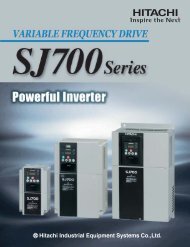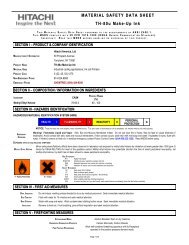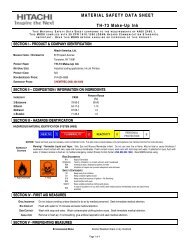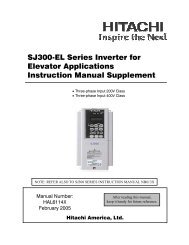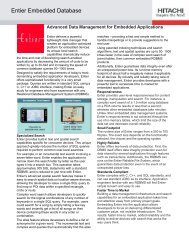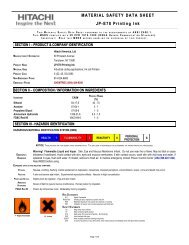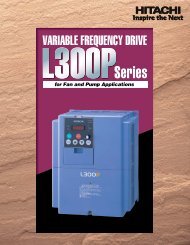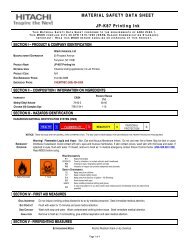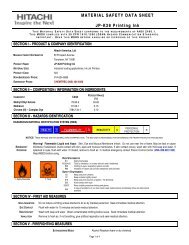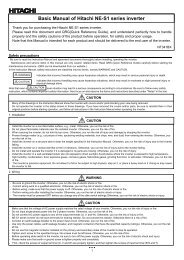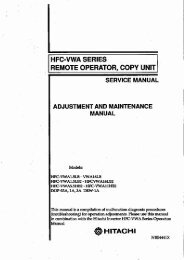SJ700-2 Instruction Manual NT204DX - Hitachi America, Ltd.
SJ700-2 Instruction Manual NT204DX - Hitachi America, Ltd.
SJ700-2 Instruction Manual NT204DX - Hitachi America, Ltd.
Create successful ePaper yourself
Turn your PDF publications into a flip-book with our unique Google optimized e-Paper software.
Chapter 5 Error Codes<br />
5.1 Error Codes and Troubleshooting<br />
5.1.1 Error Codes<br />
Name<br />
Overcurrent<br />
protection<br />
Overload<br />
protection<br />
(*1)<br />
Braking<br />
resistor<br />
overload<br />
protection<br />
Overvoltage<br />
protection<br />
EEPROM<br />
error<br />
(*2) (*3)<br />
Description<br />
If the motor is constrained<br />
or suddenly accelerated<br />
or decelerated, a high<br />
current will flow in the<br />
inverter and the inverter<br />
may fail. To avoid this<br />
problem, the inverter<br />
shuts off its output and<br />
displays the error code<br />
shown on the right when it<br />
detects a current higher<br />
than a specified level.<br />
This protective function<br />
uses a DC current<br />
detector (CT) to detect<br />
overcurrent.<br />
When a current as high as<br />
about 220% of the<br />
inverter's rated output<br />
current is detected, the<br />
protective circuit operates<br />
and the inverter trips.<br />
During<br />
constantspeed<br />
operation<br />
During<br />
deceleration<br />
During<br />
acceleration<br />
Others<br />
This protective function monitors the<br />
inverter output current, and shuts off the<br />
inverter output and displays the error code<br />
shown on the right when the internal<br />
electronic thermal protection circuit<br />
detects a motor overload.<br />
If the error occurs, the inverter will trip<br />
according to the setting of the electronic<br />
thermal function.<br />
When the BRD operation rate exceeds<br />
the setting of "b090", this protective<br />
function shuts off the inverter output and<br />
displays the error code shown on the<br />
right.<br />
If the DC voltage across the P and N<br />
terminals rises too high, an inverter failure<br />
may result. To avoid this problem, this<br />
protective function shuts off the inverter<br />
output and displays the error code shown<br />
on the right when the DC voltage across<br />
the P and N terminals exceeds a specified<br />
level because of an increase in the energy<br />
regenerated by the motor or the input<br />
voltage (during operation).<br />
The inverter will trip if the DC voltage<br />
across the P and N terminals exceeds<br />
about 400 VDC (in case of the 200 V class<br />
models) or about 800 VDC (in case of the<br />
400 V class models).<br />
When an internal-EEPROM is caused by<br />
external noise or an abnormal<br />
temperature rise, the inverter shuts off its<br />
output and displays the error code shown<br />
on the right.<br />
Note: An EEPROM error may result in a<br />
CPU error.<br />
Display on<br />
digital operator<br />
Display on<br />
remote operator<br />
OC.Drive<br />
OC.Decel<br />
OC.Accel<br />
Over.C<br />
Over.L<br />
OL.BRD<br />
Over.V<br />
EEPROM<br />
Troubleshooting and corrective action<br />
Check whether the load has fluctuated sharply.<br />
(Eliminate the load fluctuation.)<br />
Check for the short circuit of output<br />
connections.<br />
(Check the output cables.)<br />
Check for the ground fault.<br />
(Check the output cables and motor.)<br />
Check whether the inverter has decelerated the<br />
motor quickly.<br />
(Increase the deceleration time.)<br />
Check whether the inverter has accelerated the<br />
motor quickly.<br />
(Increase the acceleration time.)<br />
Check whether the motor has been locked.<br />
(Check the motor and wiring.)<br />
Check whether the torque boost current has<br />
been set too high.<br />
(Reduce the boost current.)<br />
Check whether the DC braking force is too high.<br />
(Reduce the braking force.)<br />
Check whether the current detector (CT) is<br />
normal.<br />
(Replace or repair the CT.)<br />
Check whether the motor load is too high.<br />
(Reduce the load factor.)<br />
Check whether the thermal level is appropriate.<br />
(Adjust the level appropriately.)<br />
Note:<br />
The electronic thermal protection is easily<br />
triggered when the output frequency is 5 Hz or<br />
less. If the moment of inertia of the load is large,<br />
this protective function may operate when the<br />
inverter accelerates the motor and the<br />
acceleration may be disabled. If this problem<br />
occurs, increase the torque boost current or<br />
adjust other settings as needed.<br />
Check whether the inverter has decreased the<br />
motor quickly.<br />
(Increase the deceleration time.)<br />
Check whether the operation cycle is too short.<br />
(Prolong the operation cycle.)<br />
Check whether the set BRD operation rate is<br />
too low.<br />
(Adjust the setting to an appropriate level.)<br />
Note: confirm the maximum allowable capacity<br />
of the resistor.<br />
Check whether the inverter has decreased the<br />
motor quickly.<br />
(Increase the deceleration time.)<br />
Check for a ground fault.<br />
(Check the output cables and motor.)<br />
Check whether the motor has been rotated by<br />
the action of the load.<br />
(Reduce the regenerative energy.)<br />
Check for the noise sources located near the<br />
inverter.<br />
(Remove noise sources.)<br />
Check whether the cooling efficiency has<br />
deteriorated.<br />
(Check the heat sink for clogging, and clean it.)<br />
(Replace the cooling fan.)<br />
Reference<br />
page<br />
*1 The inverter will not accept any reset command within about 10 seconds after tripping (i.e., after the protective function operates).<br />
*2 The inverter will not accept any reset command after an EEPROM error occurs with error code displayed. Turn off the<br />
inverter power once. If error code "E08" is displayed when the inverter power is turned on subsequently, the internal memory<br />
device may have failed or parameters may have not been stored correctly. In such cases, initialize the inverter, and then re-set the<br />
parameters.<br />
*3 The inverter will not accept reset commands input via the RS terminal or entered by the STOP/RESET key. Therefore, turn off the<br />
inverter power.<br />
-<br />
4-10<br />
4-31<br />
4-10<br />
4-31<br />
4-21<br />
4-38<br />
4-10<br />
4-44<br />
-<br />
-<br />
5 - 1



